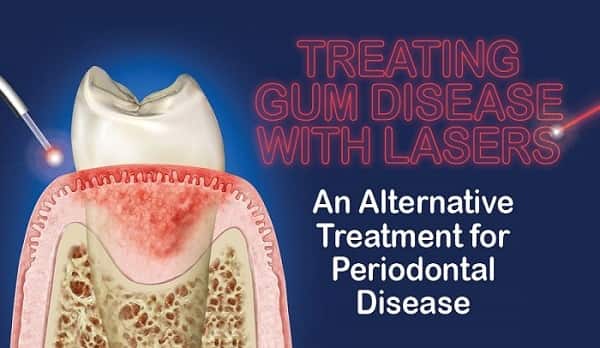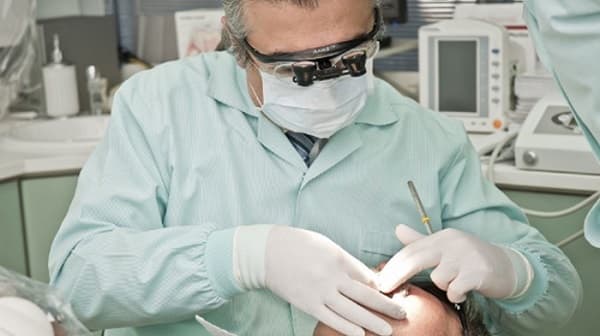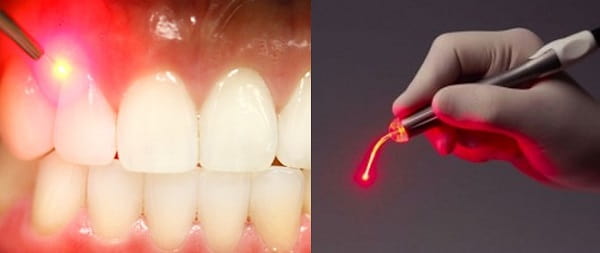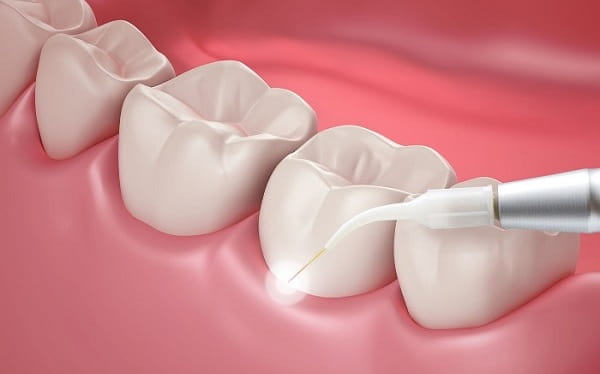Treatments for gum disease are directed at removing calculus/tartar and bacterial plaque from under the gum line. In its early stages, gum problems can often be treated with scaling and root planing which is essentially a deep cleaning under the gum line after numbing the teeth and gums. For patients with more moderate or advanced gum disease and bone loss, more sophisticated treatment is often required to properly clean out deeper deposits of disease-causing calculus (tartar) and to repair and regenerate lost bone that supports the teeth. Laser gum treatment now permits treatment without cutting or stitching and with minimal discomfort following the procedure.
Why patients have always feared traditional gum surgery
Gum disease causes the loss of teeth, often without symptoms, and is a very serious dental condition. Most patients who have gum disease are not aware they have it – and untreated, it persists as a chronic gum infection where bacterial colonies are harbored deep underneath the gum line and slowly destroy bone and tissue around teeth. Despite the devastating effects of the disease, patients have always been somewhat reluctant to have the disease properly treated. Treatment always requires the use of local anesthetic injections, and for some patients that is probably bad enough. But the prospect of surgery with cutting and stitching, discomfort, and extended recovery times can be frightening for even the most seasoned dental patients.
How laser technology can treat periodontal disease?
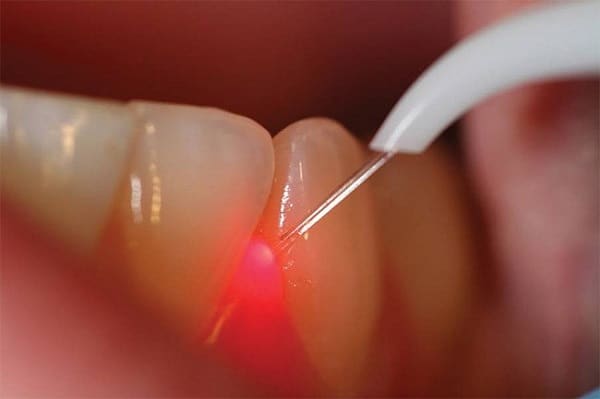
Periodontal or gum disease is an infection of the supporting tissues and bone that hold the teeth in place. Generally affecting adults in their 30s and 40s, periodontal diseases are caused due to a number of reasons, such as poor oral health, genetic susceptibility, chronic illnesses like diabetes, smoking, and certain medications.
Typical treatment for periodontal disease is scaling and root planing (SRP). This is a nonsurgical method that includes cleaning the surfaces of teeth and their roots, which may be exposed due to gum recession.
Laser treatment is a tissue-preserving, regenerative, and bone-building procedure. In general dentistry, the dentist uses a laser to access an infected pocket to kill the infected tissue and bacteria. Once the infected tissue is removed and the root is exposed, the calculus is removed with an ultrasonic root cleaner instead of scraping with hand tools. Lastly, laser energy is used to warm the stem cell that contains blood in the pocket, which creates a seal of tissues against the tooth root.
Laser treatment ensures that no tissue is subtracted or gum tissue is reduced to a lower level on purpose. It also stimulates stem cells in the tissues to form new connective tissues, bone, and collagen. The body’s healing process then regenerates the lost ligaments and bone around the tooth.
Am I good candidate?
doctor approach to complete mouth health begins with a comprehensive consultation. During this consultation, you will receive information about all your options for improved gum health and periodontitis treatment. If you’re concerned about the health of your gums, set up a consultation to get started.
Laser Gum Surgery (LANAP®) vs. Traditional Gum Surgery
For patients in need of periodontal surgery, the choice between traditional and laser treatments is important. To select the best option for you, it is critical that you understand the key differences between traditional and LANAP® procedures.
In traditional surgery, the doctor uses a scalpel to peel back gum tissue for better visibility and access to the periodontal pocket. The doctor will then cut down and suture the gums to decrease pocket depth; this is what causes the aesthetic alteration of your gum line. Once the pockets have been cut down, bone or tissue grafting may be used to reattach the gum to the tooth’s root surface.
While some severe cases of periodontitis necessitate traditional surgery, LANAP® is generally a viable alternative for most patients. LANAP® does not require scalpel or sutures, making it minimally invasive with little pain or discomfort. Because LANAP® does not require the cutting of gums to decrease pocket depth, there is little to no gum line recession, nor aesthetic alteration of your smile. The laser is able to distinguish between diseased and healthy tissue, leaving healthy tissue unaffected; this makes the procedure exceptionally selective and safe. The laser removes diseased tissue and kills living bacteria without compromising healthy gum, tooth, and bone tissue.
Limits bleeding
Numerous gingivitis patients suffer from severe gum bleeding and bone loss. Therefore, it’s critical to remove bacteria from the teeth and gingival pockets. Lasers provide the benefit of not only removing the bacteria but also killing them. This helps reduce bleeding and swelling of gums. It may even eliminate the need for further gum disease treatment such as gum surgery.
Can be optimized for patients
Based on the varying levels of periodontal disease, the wavelengths and power levels of the laser beam can be adjusted. This gives dentists ultimate control over the procedure and allows them to provide a dental treatment that is uniquely designed for individual patients and their long-term requirements.
Shorter healing time
Laser treatment causes little trauma to the gum, tooth, and surrounding areas. This means healing time is drastically reduced compared to traditional surgery. Patients will recover quicker and the whole process will be much faster.
Minimally invasive
Lasers are less invasive and eliminate the need for drills. This reduces the pressure that patients feel, which means there’s little or no need for anesthesia. The overall result is less pain and discomfort for patients. With minimal discomfort, patients will feel less anxious and relaxed during treatment.
Preserves healthy parts of the teeth
Since laser treatments are extremely precise, the technology can be used to preserve the healthy parts of the teeth while removing cavities. For patients with severe bacterial infections, preserving any healthy teeth will help ensure stronger outcomes in the long run.
Minimizes risk of bacterial infection
Because there are not multiple tools in use for a procedure, lasers help in sterilizing the area you work in and lower the risk of bacterial infections. Laser therapy helps offer better clinical results with shorter treatment times while reducing discomfort and the need for more invasive therapies. You can do this treatment with traditional surgeries or as a stand-alone treatment. You can make this decision based on the type and extent of the periodontal disease.
Pain
Traditional surgery is can be very painful as it requires cutting and suturing of the gums. Post-operative pain medication is usually prescribed and rest time is needed as part of recovery. Many patients opt to have damaged teeth extracted to avoid the discomfort of dental surgery. LANAP® protocol causes considerably less discomfort and rarely requires post-operative pain medication. There is also minimal recovery time needed, allowing patients to return to their daily routine almost immediately.
Recession
Traditional periodontal surgery requires that the gum line be cut down to decrease pocket depth. Gum line recession is usually between 2-4mm; however, in severe cases of periodontitis, the gum line may recede as much as 10-15 mm. The recessed gum line exposes tooth roots, which can be particularly sensitive to hot and cold, causing the patient discomfort while eating or drinking. LANAP® is less invasive and more selective. The laser removes only damaged tissue and does not impact nearby healthy gum and bone, resulting in no significant gum line recession. This preserves the natural appearance of the patient’s smile.
Long-term results
LANAP® protocol results are much more predictable in terms of bone regeneration and tissue attachment. The Perio-Lase® MVP-7™ stimulates the root surface, promoting regeneration and attachment. Teeth otherwise considered hopeless can be saved, restoring and functionality. Patients show further improvement after LANAP® protocol as regeneration and reattachment continue after the procedure is complete.
Cutting-edge science is constantly evolving and refining dental technology. Laser treatment is a fantastic option for many patients; however it may not be suited to all cases.
Aftercare
After having laser gum surgery it’s important to take the right steps towards healing. Even though laser gum surgery results in little to no pain or discomfort, your gums will still need to heal. The amount of time it will take for your gums to heal is affected by how well you take care of them directly after laser gum surgery.
The First Week After Laser Gum Surgery
During the first week after laser gum surgery you should opt for a liquid diet or a soft diet. This can help you avoid chewing foods in the areas of the mouth where the laser has been used.
After laser gum surgery the gums will have tiny clots (scabs) over the areas treated by the laser. It is very important to the healing process that these tiny clots are not dislodged by any excessive or unnecessary amounts of chewing or larger pieces of food. By avoiding chewing foods and having a liquid or soft diet you can aid in the healing process and recover much more quickly.
It’s also important to continue daily toothbrushing, gently. You can brush your teeth by placing the bristles of the brush on the gums below the tooth and carefully rolling the bristles toward the tooth surface. Do not stick the bristles into the gums, this will be too harsh for the tiny clots and could cause them to become dislodged.
The Second Week After Laser Gum Surgery
During the second week after laser gum surgery it is ok to resume your normal diet. It is advised that you continue to be careful and avoid chewing in the area of your mouth where the laser gum surgery was preformed. You may also resume normal teeth brushing at this time, but it is still advised to be proceed carefully and gently.
The amount of time it takes to heal after laser gum surgery depends on the severity of the disease. Generally, healing in the surface area takes 2 to 4 weeks to completely heal.
What kind of dentist is best qualified to perform laser gum treatment?
Periodontists are surgically-trained dentists who spend an additional three years of university or hospital-based residency training (following four years of dental school) specializing in the diagnosis and treatment of gum disease. Periodontists are generally considered the most appropriate type of dental specialist to treat moderate and advanced cases of gum disease due to their advanced training, education, and clinical experience.
Unortunately, there are quite a few general and family dentists without advanced training in the diagnosis and treatment of gum disease offer these same services. Many of these dentists have only minimal training in the use of lasers in dentistry, and moreover, have absolutely no formal training in periodontal or gum surgery. Periodontists, therefore, remain the dental specialist of choice for laser gum treatment, and for the diagnosis and treatment of gum disease.
How much does laser gum surgery cost?
Laser-assisted periodontitis treatment may sound expensive, but it doesn’t have to be. The average cost of LANAP treatment depends on how many areas you need the treatment on. However, it is not just about the cost of LANAP treatment itself. More traditional treatments involve invasive surgeries, removing of the gum tissue and they are not able to regenerate the bone back.

